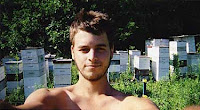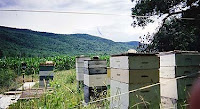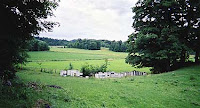
I had a hunch about what’s inside those white boxes you sometimes see along rural back roads. They always seemed to stand silently as I sped from errand to errand, along the roads I drove to get me off the busier highways.
My summer experience at Honey Gardens Apiaries was just that “getting off the busier highways”. And I came to understand that such peace is in the essence of beekeeping.
As I was focusing my energy on graduating from Bard College in the Hudson Valley of New York, I tried some amazing honey thanks to my friend April Howard. She told me that she was an old family friend of Todd Hardie, the founder and continuous inspiration behind Honey Gardens. Todd and I met in Vermont before the snow had melted, and, with both of us taking faith in the friendship that was blossoming, in May I moved my van to the back of the honey house and had myself a house for the summer. On that first night, hearing the coyotes that lived close by certainly aided the feeling that I had no idea what I was getting into.
The next day I was stung five

times as I walked to my first bee yard. I had not yet put on my veil. I said to myself, OK bees, and waited for any kind of allergic reaction. Tim McFarlane, who would be one of my many mentors over the summer, was supportive. And then he made sure that I was no stranger to good, hard work.
I would not have brought myself to this situation if I weren’t confident in my own ability to adapt. That’s just what I did and not just to the bee stings, which are pretty much unavoidable. It’s the life of a beekeeper: up in the morning, sometimes before dawn to move hives full of drowsy bees and tired and satisfied in the evening. Taking each day with the sustenance of working with and being a part of nature. (Remember, beekeepers have the lowest cancer rate of any occupation.)

It was not long until the day came when I pulled a strange looking frame out of a hive. I called to Tim, who was busy checking for bee eggs on the other side of the yard. Tim, what is this stuff? It’s HONEY COMB. Eat it! And I did. And it was wonderful.
So many other grand opportunities ensued: the first taste of royal jelly, pulling the first honey of the season, the celebration of extracting honey from bees I placed in the field, and always working with the bees and understanding them better. I was joining noble ranks here: visiting the uncanny queen breeder Anicet Desrochers in north Quebec, relating with beekeepers all over upstate New York and Vermont, realizing that beekeeping creates one large family.
Our work with plant medicine

also put me in touch with herbalists and many groups of people committed to finding a better relationship between humanity and its surroundings. It is really something to fall asleep and dream about purple loosestrife. It seemed that I had a ticket to expand my world view, finding happiness in beekeeping, living off-grid, and enjoying the minute particulars that make summer in Vermont.
top 10 ways that you can help the bees
1. stop cutting and using artificial fertilizer on your lawn
Most lawns have many flowers that give nectar and pollen to honey bees and other pollinating insects. These give life to the bees at a time when their natural sources of nourishment are being diminished. Seeing the natural expression of a lawn is a beautiful thing, and not cutting it will save time and reduce pollution from not using the lawnmower.
2. buy honey, beeswax and other bee products from local beekeepers
Much of the honey in stores over the years is dead, contaminated honey from China and other parts of the world. Safety is in question. By using local honey, you are supporting quality and the pollination of your food and flowers at home, as well as the local agricultural economy.
3. think about it all after you get stung by a “bee”
Most of the time people get stung, they blame it on a honey bee, while it is actually one of their “aggressive cousins”, the wasps, hornets, and yellow jackets. But with whatever stings you, this small creature is protecting itself from you, the big aggressor. The value of bee venom therapy is also increasingly recognized as being very medicinal with its role in being an overall health tonic, for treatment of some cases of multiple sclerosis, rheumatoid arthritis, and now Lyme disease.
4. plant trees and flowers that will feed the bees
As you plant locust, willows, red maples, basswood trees and grow flowers that attract the bees like borage and bee balm, the honey bees in your neighborhood will have more to eat and be strengthened. Insects pollinate almost 40% of our food supply, with much of this being done by honey bees, and as the value of pollination is many more times more important than the honey we get from these, you can help by establishing sources of for the bees.
5. advocate for GMOs crops to be banned to help protect the honey bee
6-10… We will be grateful to get your ideas to complete this. todd@honeygardens.com